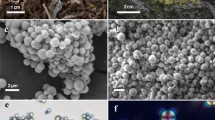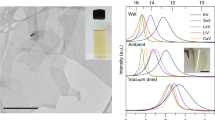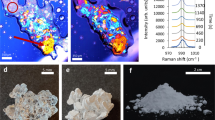Abstract
GRUNER1 has shown that vermiculite consists of talc-like layers, 9·26 A. high, alternating with water layers (4·95 A.), the total water content of the mineral being in the region of 20 per cent. Theories2,3 as to the nature of the water layers have found difficulty in explaining the observation1,2,3 that, when vermiculite is heated at 110° C., about half the water is removed without apparently affecting the diffraction pattern. It can be shown, however, that a change in the structure does, in fact, take place during this treatment ; but that the rapid rehydration which occurs on contact with normal atmospheric conditions tends to obscure it. Thus, while the diffraction patterns of unheated and rehydrated samples are identical, a powder specimen heated at 110° C, and sealed in a thin glass tube before rehydration can occur does not give the usual 14·2 A. basal reflexion of vermiculite but one at 11·8 A. corresponding to a water-layer thickness of 2·54 A., which is about half the original value. A single flake similarly treated shows the 11·8 A. reflexion to be associated with a regular sequence of higher orders ; that is to say, it represents a real spacing and is not a diffraction effect from intimately mixed layers of different sizes4. It is clear, therefore, that removal of half the water is accompanied by replacement of an original double water-layer by a single layer.
This is a preview of subscription content, access via your institution
Access options
Subscribe to this journal
Receive 51 print issues and online access
$199.00 per year
only $3.90 per issue
Buy this article
- Purchase on Springer Link
- Instant access to full article PDF
Prices may be subject to local taxes which are calculated during checkout
Similar content being viewed by others
References
Gruner, J. W., Amer. Min., 19, 557 (1934).
Gruner, J. W., Amer. Min., 24, 428 (1939).
Hendricks, S. B., and Jefferson, M. E., Amer. Min., 23, 863 (1938).
Hendricks, S. B., and Teller, E., J. Chem. Phys., 10, 147 (1942).
Hendricks, S. B., and Jefferson, M. E., Amer. Min., 23, 851 (1938).
Author information
Authors and Affiliations
Rights and permissions
About this article
Cite this article
WALKER, G. Water Layers in Vermiculite. Nature 163, 726–727 (1949). https://doi.org/10.1038/163726a0
Issue Date:
DOI: https://doi.org/10.1038/163726a0
This article is cited by
-
Evaluation of thermodynamic quantities etc. in the cation exchange of Mg2+ from magnesium saturated bentonite and vermiculite
Kolloid-Zeitschrift und Zeitschrift für Polymere (1971)
-
Oxonium groups in vermiculite
Journal of Structural Chemistry (1962)
-
Vermiculite-Organic Complexes
Nature (1950)
Comments
By submitting a comment you agree to abide by our Terms and Community Guidelines. If you find something abusive or that does not comply with our terms or guidelines please flag it as inappropriate.



